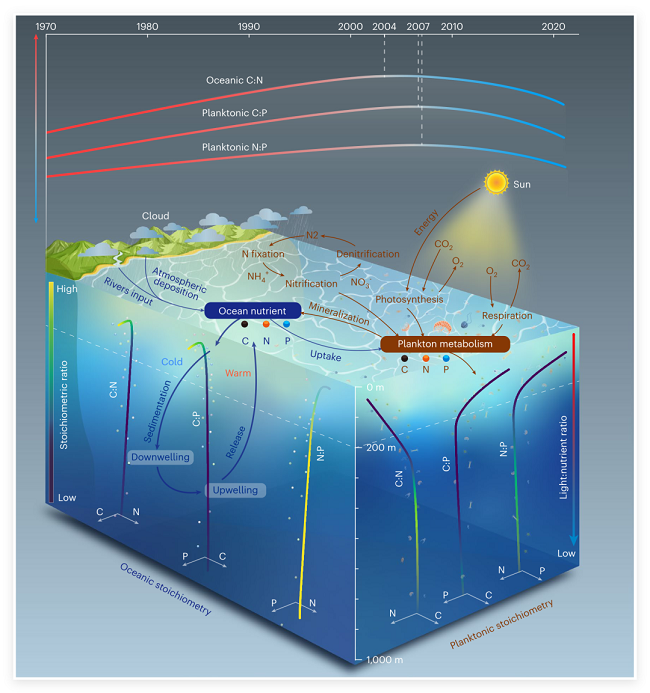A new study published in Nature Geoscience reveals that the chemical composition of the global ocean is undergoing a fundamental transformation. Using decades of observational data, researchers found that the molar ratios of carbon (C), nitrogen (N), and phosphorus (P)—three key elements essential for marine life—have systematically deviated from the widely accepted Redfield Ratio.
The Redfield Ratio, proposed in the mid-20th century, suggests a consistent elemental ratio of 106C:16N:1P in marine organic matter. This concept has been foundational for understanding ocean nutrient limitation, plankton productivity, and carbon cycling. However, by compiling over 56,000 particulate organic samples and nearly 389,000 dissolved nutrient measurements collected from the surface to 1,000 meters depth between 1971 and 2020, the research team has created the largest global dataset of ocean stoichiometry to date.
Led by the Institute of Earth Environment of the Chinese Academy of Sciences and co-authored by scientists from Central China Normal University, the Spanish National Research Council, Yale University, Princeton University, and the University of Southern California, the study found that both organic and dissolved C:N:P ratios have been steadily shifting over the last five decades—with clear patterns across space and time.
Specifically, the C:P and N:P ratios in phytoplankton have increased globally, indicating a growing prevalence of phosphorus limitation in marine ecosystems. Meanwhile, rising C:N and C:P ratios in surface waters suggest increasing carbon enrichment. Notably, the study detected a turning point around 2007, after which previously rising C:N and N:P ratios in phytoplankton began to decline gradually. This shift may reflect enhanced phosphorus inputs from human activities—such as agriculture, wastewater discharge, and industrial runoff—that have altered nutrient dynamics in certain regions.
In addition to long-term trends, the researchers observed distinct vertical gradients in ocean stoichiometry. As depth increases, C:N and C:P ratios in dissolved matter decline, while N:P ratios rise. This is likely due to the preferential decomposition and loss of carbon during organic matter sinking, coupled with the retention of nitrogen and phosphorus in dissolved inorganic forms. Changes in microbial community composition with depth—from surface-dwelling phytoplankton to deeper heterotrophic bacteria—also contribute to these patterns.
Despite these dynamic shifts, the study found that the C:N ratio in phytoplankton has remained remarkably stable over the past 50 years. The authors attribute this to a phenomenon known as “stoichiometric homeostasis,” where plankton regulate their nutrient uptake and cellular composition to buffer against environmental changes. This biological stability highlights the adaptive capacity of marine organisms, while also emphasizing that stoichiometric shifts are driven by both physiological responses and community restructuring.
The findings challenge the long-standing assumption of a fixed C:N:P ratio in ocean biogeochemistry. The authors argue that Earth system and climate models should incorporate variable and dynamic stoichiometric structures, rather than relying on static nutrient ratios. Ignoring such variability could lead to inaccurate estimates of ocean carbon uptake, nutrient limitation mechanisms, and climate feedbacks.
As climate change accelerates and carbon cycling becomes increasingly critical to global sustainability, this study offers vital empirical evidence for rethinking how nutrient dynamics shape the ocean’s role in Earth’s climate system—and provides a data-driven foundation for future marine carbon management and conservation strategies.

Fig. 1 Conceptual diagram of the spatiotemporal variation in marine carbon, nitrogen, and phosphorus stoichiometry (Image by LIU Ji)
 © 2015 Institute of Earth Environment,CAS
© 2015 Institute of Earth Environment,CAS Address:No. 97 Yanxiang Road, Xi'an 710061, Shaanxi, China

 Location :
Location :